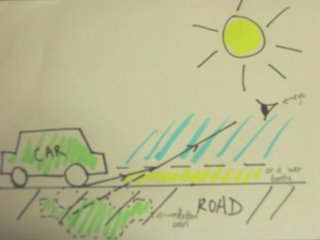Things Heat Up!
Have you ever wondered why the roads look wet even though it did not rain prior, and the sun is shining so brightly?
When I was in primary school, I used to be so amazed at how the "wet" roads so quickly turned dry as my dad's car approached the "puddle". I never figured where the elusive puddle went, I just assumed it evaporated fast enough before we could approach it! Well, silly it is, but at least it "explained" where all that water went!
But actually, there never really was water to evaporate. The reason you even think there is water is because of the reflection you see on the road (or really, just any really hot surface). The presence of the reflection makes you think that there is a puddle of water, because it only seems logical in your brain as it processes the information.
Hmmz, this is when I'll fish out my brilliant art piece...
 Now, now, don't you just love this? I would have made a great artist, I say.
Now, now, don't you just love this? I would have made a great artist, I say.
I've got to explain why you even get the reflection, because that's the real reason you even think there is water on the road.
What happens is this: The sun heats up the road, which in turn heats up the air just above it. Then the air above the road is warmer than those above it. Yes, I know you'll say hot air rises, and that's true, but this isn't the equilibrium state - some air just above the road is warmer. And because it's warmer, it's less dense.
(I've drawn an idealised version, where this is only one layer of less dense air represented by yellow. In reality, the air above the road has a density which varies with height, but let's just keep things simple...)
When a ray of light leaves a less dense material (and hence lower refractive) index, for those of you who know the word...), to a denser material (higher refractive index), it bends (i.e. refracts). And it bends in a direction closer to what is known as the normal (it's the dotted vertical line in this case, if you can see it in my artistic diagram...).
Your eyes (or maybe brain) assumes that the light travels in a straight line, and hence traces back the ray (which enters the eye) with a straight line. And as it does that, it forms an image on the road (all this processed in the brain), which is why you see this inverted "reflection" image.
It's hard to explain this in words, but I hope the diagram is clear enough!
Phew, one mystery solved for you today!

0 Comments:
Post a Comment
<< Home